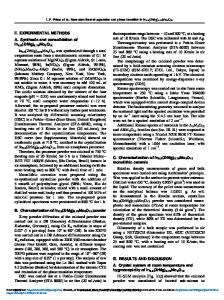Negative or Zero Thermal Expansion in Silicon Dicarbodiimide, Si(NCN)2
- PDF / 152,645 Bytes
- 6 Pages / 612 x 792 pts (letter) Page_size
- 26 Downloads / 445 Views
1040-Q01-05
Negative or Zero Thermal Expansion in Silicon Dicarbodiimide, Si(NCN)2 Peter Kroll1, Xuehua Yan2, Ralf Riedel3, and Helmut Ehrenberg4 1 Chemistry and Biochemsitry, University of Texas at Arlington, 700 Planetarium Pl, Arlingtom, TX, 76019 2 School of Materials Science and Engineering, Jiangsu University, Zhenjiang, 212013, China, People's Republic of 3 Institut fuer Materialwissenschaft, TU Darmstadt, Darmstadt, 64287, Germany 4 Institute for Complex Materials, IFW Dresden, Dresden, 01171, Germany ABSTRACT Using ab-initio molecular dynamics simulation we investigate the thermal expansion of β-Si(NCN)2 for temperatures up to 700 K. We find that the structure behaves isotropic, although its optimized ground state is tetragonal. Studying the zero-pressure volume as a function of temperature we find a negative expansion of the structure and a linear expansion coefficient αL of -2·10-5 K-1. We attribute this effect to a strong bending of the Si-N=C angle within the structure which increases on increasing the temperature. The stretching of Si-N and C=N bonds on the other side is regular. Experiments motivated by the computational study were carried out on nano-crystalline Si(NCN)2 powders. The XRD Mo Kα data shows a negative thermal expansion for β-Si(NCN)2 up to 600 K. Synchrotron data indicates zero expansion of β-Si(NCN)2 between 460K and 800 K. INTRODUCTION The ternary crystalline compound silicon dicarbodiimide, Si(NCN)2, was synthesized about a decade ago [1]. It exhibits two modifications, α and β, which are related through a reversible phase transformation at 150ºC. The high temperature phase, β-Si(NCN)2, has been structurally characterized by in-situ X-ray diffraction. It’s structure is cubic (space group Pn3m) and resembles that of two interpenetrating cristobalite-like networks. The structure of the lowtemperature modification α-Si(NCN)2 could not be resolved due, not at least due to the small size of the crystals (10-20 nm). However, since the structure of β-Si(NCN)2 resembles that of high-cristobalite SiO2 – through replacing the O by the carbodiimde group NCN – it can be assumed that the low-temperature structure α-Si(NCN)2 is similarly related to low-cristobalite SiO2 as well.
Figure 1: Unit cell of the cubic β-Si(NCN)2 (space group Pn3m). It is commonly assumed that the structure is highly idealized and reflects the average positions, since the Si-N and C-N distances, 1.56 Å and 1.12 Å, are much too short. Moreover, thermal ellipsoids indicate substantial static and dynamic disorder at every site of the structure.
In a comprehensive computational study of silylcarbodiimides in the molecular and extended state we had investigated Si(NCN)2 using density functional methods [2]. We gave details on the structure of cubic β-Si(NCN)2 and indicated that the Si(NCN)2 system indeed has a strong resemblance to the cristobalite-SiO2, including the fine structural details of β-SiO2 and probably α-SiO2. Moreover, we attributed much of the structural features to the flexibility of the carbodiimide (NCN) m
Data Loading...










